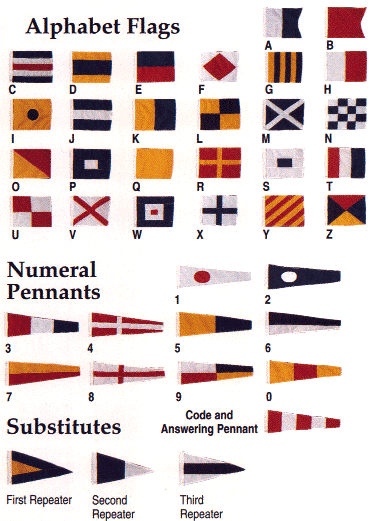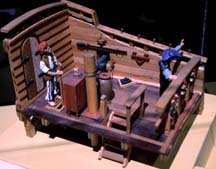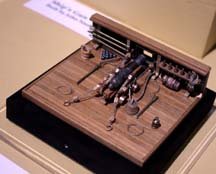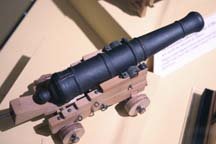Sailing through History with Model Ships
Elements of a Ship
Figureheads
From ancient times it was common to place a decoration at the bow of the ship so that other ships (or maybe supernatural beings) could identify her from a distance. It was commonly believed that the figurehead would please the sea gods and assure a safe passage.
Anoather common belief was that a ship was in some sense a living being and therefore in need of a head -- and especially eyes, a common decoration (which probably originated in Egypt and was spread by the Phoenicians and Greeks) on ships sailing the Mediterranean sea. Even today, fishing boats having eyes painted on the bow can be frequently observed in the Mediterranean. Eyes also appear on the Dragon Boats that are raced in China and other Asian countries. Viking ships often had dragons or other animal heads mounted on the bows of their ships to give them a fearsome aspect and to aid in identification of a ship. Egyptian ships often had carved birds, and the Phoenicians used horse heads to invoke swiftness. The militaristic Romans often had a carved centurion at the bows of their military ships. Swans were popular for merchant vessels. These carved images are the origin of the figureheads that decorated later ships.
In the late 18th century it became fashionable to have a figurehead related to the name of the ship mounted on the bow. Many were quite elaborate, and for the next century, figureheads enjoyed their heyday as works of art.
Although they could represent men, mythical figures or animals, most were carvings of females, usually bare-breasted. However when wives and daughters of New England captains and ship owners modeled for figureheads they compromised by wearing low-cut dresses. The figurehead at the right is from the bark Edinburgh, and was featured on a U.S. international postcard stamp in 1974.
Flags
Flags identify ships and pass messages from one vessel to another. National flags identify a ship's country of origin. International code flags deliver messages.
Semaphore flags used by a crew member pass messages over short distances.
Each flag, or combination of flags, has a different meaning. A flag may represent a single alphabetical character or number or may have a more complex meaning. For instance, the yellow flaq used for the letter "Q" also means the ship is in quarantine when flown alone. The "P" flag flown alone indicates a ship is preparing to leave port. On sailing ships, a flag on one mast can mean something different from the same flag on a different mast.
Naval ships often used a string of flags (a hoist) to identify themselves. Each ship was given a "serial number" which was published in a list circulated to a countries naval vessels. A friendly ship displaying "243" might thus be identified as to ship and captain by its compatriots.
Hulls
The earliest shipbuilders made their vessels of reed bundles or hollowed-out tree trunks. When they added individual planks to the sides of a dug-out log, they made the first clinker-built (overlapped strips) hull.
The Vikings' vessels were clinker-built (made of overlapped wooden planks). Moss or wool tucked into the joints made the hulls more or less watertight.
On the Mediterranean Sea and Indian Ocean the ships were carvel-built with planks fitted edge to edge and sealed with pitch or other caulking materials.
Builders put decking over the hull to allow for more cargo, then added raised platforms. By the 13th century the platforms had crenellated walls and looked like small castles.
Fore-castles (fo'c'sles) acted as raised fortresses. The after castles, which became integrated into the structure of the hull, were the appropriate place for officers' cabins. The after castle gradually elongated and became cabin space and the quarterdeck.
Oars
The earliest watercraft used oars or paddles for propulsion and steering. As ships grew larger, large numbers of rowers were used to move the ship against the wind or for speed under combat conditions. In most cases, the rowers were slaves or prisoners, although Viking raiding ships often were rowed by the raiders themselves.
The larger oared ships are generically known as galleys. They usually were also equipped with sails for use over long distances or to allow rest periods for the rowers. Galleys were used by some nations as gunboats for coastal and harbor defense until the introduction of the steam engine.
Merchant ships, which had to operate at a profit, usually were sailed to minimize crew expenses and to allow maximum use of hull space for cargo, although some were equipped with a small number of oars for harbor manuevers. Most large oar-propelled ships were warships or royal pleasure craft: the state provided the rowers and covered expenses.
Oars and paddles are still used today with small boats, canoes, and rafts.
Rigging
Sailing ships have two types of rigging:
Standing rigging includes the lines, wires and chains that support the masts and the yards that carry sails.
Running rigging is used to hoist, lower or trim the sails.
Sailors use many kinds of lines on a ship, from thin twines and yarns to thick hawsers.
Sails
Until the introduction of the steam engine, ships were moved by oars or sails. Square sails hang from the yards at right angles to the mast. When the wind comes from behind the ship, they drive the ship forward efficiently.
Fore-and-aft sails are set parallel to the long axis of the ship with the leading edge attached to a mast or stay. They are more efficient than square sails when the ship sails close to (more nearly into) the wind.
Ancient Egyptian, Roman and Viking vessels used square sails set on short masts. Sailors soon discovered that by setting the sails at an angle, they could sail a vessel upwind to a degree.
Sometime in the 15th century the square and the fore-and-aft sails were used together to create the full-rigged ship. It was more maneuverable, safer and easier to manage than a ship with a single type of sail.
Sail-makers have decorated sails since the earliest days of navigation. In ancient Egypt they had a checkered pattern of red, purple, blue and white. Cleopatra ordered a purple sail embroidered with flowers. Viking sails usually had diagonal stripes.
In the Middle Ages sails carried the coats-of-arms of the knights who sailed on the ships. By the middle of the 16th century elaborate religious designs took their place.
Steering: Tiller, whipstaff and wheel
The smallest watercraft were (and still are) steered by moving paddles or oars appropriately. In classical times, ships were guided with a steering oar, a long oar attached to the stern of a ship. On larger ships, they may have been two steering oars, one on each side. Small boats are steered with a tiller, a horizontal bar connected to the top of the rudder shaft. The whipstaff migrated that concept to larger watercraft. The steering bar is vertical and is connected to the rudder by a mechanical linkage. The whipstaff was used through the 17th century. This kit, built by Harold H. Patton, shows how it worked. Ships required higher stern decks to use this steering device. It could only turn the rudder about 5º from center in either direction.
Steersman, 19th c.(Kit built by Harold H. Patton)
The steering wheel used on more recent ships uses ropes and pulleys to transfer the motion of the wheel to the ship's rudder. If the rudder is large and the sea is rough, it takes considerable effort to control the wheel and keep the ship on course. With the steering station shown, four men can work together in rough seas. This arrangement provided much better control of the ship because the rudder could be moved through a larger range of motion, and a larger rudder could be used.
Modern ships use special engines to move the rudder (some large ships may have multiple rudders) in response to wheel motions, and the wheel is located on an enclosed bridge where it is not (hopefully) exposed to wave and weather. Originally the rudder engines were steam driven, but modern practice is to use electric motors or hydraulic mechanisms to position the rudder.
Some contemporary ships have auxiliary steering systems for use at low speeds in which jets of water are used to swing the bow or stern, or even move the entire ship sideways. These can literally turn the ship in its own length and are extremely useful when docking or for maneuvers in close quarters.
Gun station
A standard gun station, 18th - 19th century, (Kit built by John Wilkins, 25 hours) This typical gun station shows basic tools and working lines. The gun is mounted on a carriage which helps to position the gun and absorb recoil when the gun is fired. Guns of this type were muzzle loaders. (The gun model is by John Nash.)
The broadside mounted guns of this type were awkward to aim because the carriages were quite hard to shift. Vertical elevation was somewhat easier, but fairly crude. Prior to the introduction of elevating screws, wood wedges (quoins) were positioned under the rear of the barrel to control elevation and range. Broadside mounted guns were replaced by turret mounted guns, which were more effective (as demonstrated by the US Civil War engagement between the ironclads Monitor (turret) and Merrimac (broadside)), because they were easier to aim and didn't require moving the entire ship to obtain a wide arc of fire.
Steamships
The first steamship with much practical value was the paddle steamer Clermont. Robert Fulton built her and sailed her up the Hudson River in 1807.
The Savannah was the first steamship to cross the Atlantic, in 1819. She was a fully-rigged ship that also had a 90-horsepower engine that drove wheel shafts.
The paddle wheels were 16 feet in diameter and fitted with chains so that the wheels could be folded up when the sails were in use. According to the log book the steam engine served for 18 days and the sails for five. The engine burned coal and wood.
By the late 1850s the screw propeller replaced the paddlewheel and the steamship began to replace the sailing ship.
Steam turbine-driven engines were introduced for warships by the early 20th century.
The Model Ships
Ship in a Bottle
Toy Ships
What kind of ship is that?
This page last updated: October 29, 2007
Original content: Copyright © 2000 - 2007 Museum of American Heritage
Trademarks are the property of their owners





